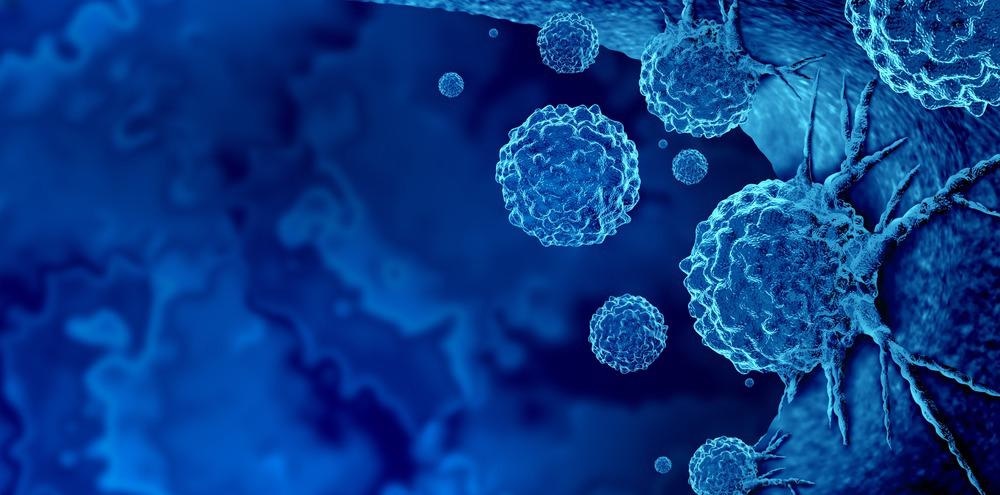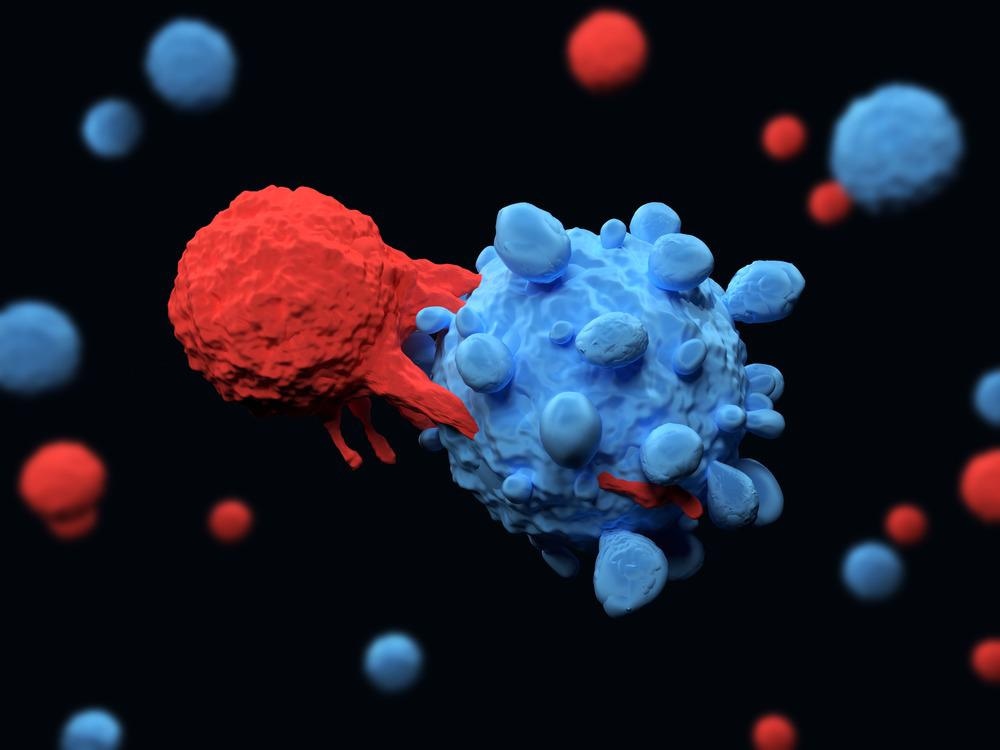Tumors can effectively evade the immune system
Over 150 years ago, a possible link between the immune system and cancer was first highlighted by Rudolph Virchow who observed the prevalence of leukocytes within the tumor environment. Currently, the ability of tumors to evade the immune response is one of the hallmarks of cancer with at least 25% of cancers associated with chronic inflammation. This led to the development of immunotherapy starting as early as the nineteenth century.
The processes in which tumors evade the immune system are highly studied yet not fully elucidated. There are several key insights to be gained from studies that can help to uncover the mechanisms of how the immunosuppressive tumor microenvironment (TME) can effectively evade immune surveillance. A knowledge of these processes can help understand how a patient may respond to therapy.

Image Credit: Lightspring/Shutterstock.com
Immunosuppressive mechanisms used by tumor cells involve cytokines and hormones
Generally, the immune system works to identify foreign “non-self” antigens present on pathogenic, infected, or malignant cells. The immune response then targets and destroys the cell or pathogen while protecting the host and developing an immunological memory of the foreign antigen for future encounters.
The cells of the immune system rely on antigens and various messenger molecules such as cytokines to enact proinflammatory and anti-tumor actions. There is a well-recognized three-stage process that tumors follow to avoid immune surveillance, the stages are labeled elimination, equilibrium, and escape.
Elimination phase: immunodetection and destruction of tumor cells
During the early stages of tumor development, cytotoxic immune cells such as natural killer (NK) and CD8+ T cells recognize and eliminate the more immunogenic cancer cells. During the process of cancer pathogenesis, the innate immune system (such as NK cells and macrophages) is activated by tumor antigens and pro-inflammatory cytokines to minimize cancer-mediated inflammation, a process that also activates adaptive immune responses (such as T lymphocytes) for targeting cancer via more specific mechanisms. The first elimination by NK and CD8+ T cells selects for malignant cells that are less immunogenic and more invisible to immune detection.
Equilibrium phase: tumor cells remain under immune-mediated dormancy
Tumor cells will maintain themselves in a state of functional dormancy; this phase is poorly understood due to its difficulty to model. In this stage the tumor remains dormant, undergoing genetic and epigenetic changes by maintaining a balance of interleukins (ILs) which are a type of cytokine mediating communication between the tumor and immune cells.
A balance of IL-12 which promotes elimination, and IL-23, which promotes persistence is kept. This is a simplified explanation of a process that may involve many other IL subtypes and signaling molecules such as interferons (IFN).
A case study of two recipients without primary melanoma received a kidney from the same donor who had previously had primary melanoma and was thought to be tumor-free for 15 years; however, both recipients were later diagnosed with secondary melanoma of the kidney after immunosuppressive therapy. The removal of immune suppression took the dormant tumor cells out of the equilibrium phase.
Escape phase: avoiding immune surveillance
In this phase, the tumor cells are no longer suppressed by the immune system; this can occur in many ways such as reduced immune recognition, increased resistance or survival, or the development of an immunosuppressive TME. Reduced immune recognition is a result of immunoediting, where the immunogenic cancer cells have been destroyed leaving fewer immunogenic tumor cells that do not display antigens that stimulate the immune response. This can occur with the loss, downregulation, or aberrant expression of major histocompatibility complex (MHC) class-1 molecules that display tumor antigens to stimulate T-cell action. Increased resistance or survival can occur via epigenetic or genetic changes within the tumor cell.
Once the tumor matures and is established, it can induce immunosuppression via the recruitment of non-tumor cells into the TME. Recruitment of high levels of infiltrated T cells correlates with a good prognosis in many cancers, but high levels of macrophage infiltration indicate a worse prognosis. Initially, anti-tumor macrophages play a proinflammatory role (M1 type) which eliminates immunogenic tumor cells, but as the tumor progresses, the tumor microenvironment polarizes the macrophages into an anti-inflammatory (M2) and protumorigenic role.
Tumor-associated macrophages (TAMs) stimulate angiogenesis which stimulates cancer cell proliferation, epithelial-mesenchymal transition, and metastasis observed mostly in primary tumors. TAMs secrete cytokines (IL-10 and TGF-beta) which induce immunosuppression, impairing the activity of other immune cells like effector T cells. TAMs promote proliferation through the secretion of epidermal growth factor (EGF) hormones, angiogenesis by vascular EGF (VEGF), and remodel the extracellular matrix by secreting metalloproteinases (MMPs). Macrophage-derived MMP-9 promotes tumorigenesis and angiogenesis.
T lymphocytes are the second most frequent immune cells to be found in the tumor environment alongside TAMs. The presence of CD8+ T cells and Th-1 cytokines, which promotes antitumor responses via secretion of proinflammatory cytokines, correlates with greater overall survival and disease-free survival. During tumor development, tumor cells can mimic peripheral tolerance, a natural mechanism that prevents autoimmunity by ensuring T cells that react to self-antigens are deleted or become inert. This mechanism also helps to avoid TAMs, neutrophils, and NK cells.

Image Credit: Meletios Verras/Shutterstock.com
Immune-tumor interactions could personalize cancer care in the future
Cancer immunotherapies are a class of treatments under the precision medicine umbrella that utilize innate and adaptive immunity. These therapies include vaccines, monoclonal antibodies, recombinant cytokines, small molecules, and autologous T cells. The properties of the tumor such as stage, site, and type dictate which type of therapy is the most suitable. Despite the promising nature of these treatments, there is a high relapse rate.
In April 2010, the FSA approved a vaccination for advanced prostate cancer which contains the tumor antigen-prostatic acid phosphatase (PAP). The mechanism of action involves the uptake of PAPs by antigen-presenting cells, which then activate T cells, cause differentiation and initiate their effector function.
Cancer cells can manipulate and evade the immune system in a variety of different ways, requiring new therapeutic methods to adapt to each individual cancer.
Sources:
- Pandya, PH., et al. (2016) The Immune System in Cancer Pathogenesis: Potential Therapeutic Approaches. J Immunol Res. doi.org/10.1155/2016/4273943
- Gonzalez, H., et al. (2018) Roles of the immune system in cancer: from tumor initiation to metastatic progression. Genes Dev. doi.org/10.1101/gad.314617.118
- Vesely, MD. and Schreiber RD. (2013) Cancer Immunoediting: antigens, mechanisms and implications to cancer immunotherapy. Ann N Y Acad Sci. doi.org/10.1111/nyas.12105
- Mittal, D., et al. (2014) New insights into cancer immunoediting and its three component phases – elimination, equilibrium and escape. Curr Opin Immunol. doi.org/10.1016/j.coi.2014.01.004
- Wang, HF., et al. (2019) Targeting Immune-Mediated Dormancy: A Promising Treatment of Cancer. Front Oncol. doi.org/10.3389/fonc.2019.00498
- Xing, Y. and Hogquist KA. (2012) T-Cell Tolerance: Central and Peripheral. Cold Spring Harb Perspect Biol. doi.org/10.1101/cshperspect.a006957
- Adams, JL., et al. (2015) Big opportunities for small molecules in immuno-oncology. Nat Rev Drug Discov. doi.org/10.1038/nrd4596
Further Reading
Last Updated: Apr 13, 2022